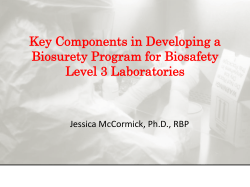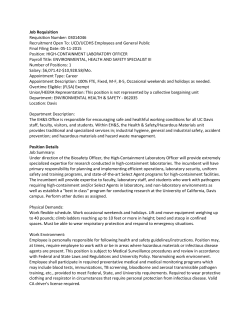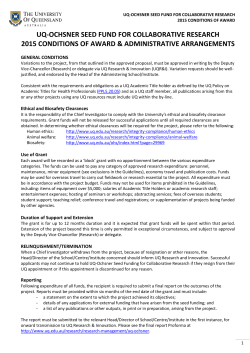
Building a Sustainable BSL-2 Lab Biosafety Program in Low
Building a Sustainable BSL-2 Lab Biosafety Program in Low-Resource Countries: Success in the Republic of Georgia Stephen Rohrer, Ph.D, RBP Threat Agent Detection & Response Program, Branch of Battelle Memorial Institute in Georgia, Tbilisi, Georgia ABSA Conference October 21-24, 2013 Kansas City, MO Approved for public release; distribution is unlimited Pathogen Surveillance Network in Georgia • Establish a surveillance network for early detection of pathogens and disease; extremely dangerous pathogens (EDPs) • Build and staff modern diagnostic laboratories; • Train and equip lab staff to detect, investigate, diagnose, and confirm human and veterinary EDP outbreaks. • Establish written procedures & manuals to be followed. Requires a Biosafety Program that meets international standards and best practices but is also sustainable. H V VET ZDL v VET LSS H HUMAN ZDL H HUMAN LSS CPHR v H v v H H Dusheti V H v Ozurgeti H H V v H H v V Gurjaani H V v Human: ZDLs at NCDC (Tbilisi), Kutaisi and Batumi; 7 new LSSs co-located with Regional Public Health Centers. Veterinary: ZDLs at LMA (Tbilisi), Kutaisi and Akhaltsikhe; 8 LSSs throughout Georgia Capabilities of ZDLs and LSS’s BSL-2 rating, Biosafety cabinets, fluorescent microscopes, Sample receipt and preparation, Bacteriology, Serology, Real-time PCR, Waste Autoclave, Incinerator • • • • • • BSL-2 rating Biosafety cabinets Sample receipt and preparation, Basic serology, Also basic bacteriology in H-LSS, Waste autoclave in H-LSS BS&S Sustainment Goals • Sustainment - Function of an effective, mature biosafety & biosecurity program used throughout Georgian network of surveillance labs. • Sustainability – Ability to maintain program with reduced DTRA funding by Jan 2016. Funding, technical expertise, teaching & training, maintaining equipment & supplies, continued compliance. Factors Affecting Sustainability of BS&S • • • • • • • • • Cost to maintain BS&S program that is built Technical capabilities to run the BS&S program Level of bio risk changes with sustainment? Which standards to use and degree of compliance? Lack of operational practice with EDPs; few samples come to lab Supply limitations; inventory control; expired items Training capabilities; future BSOs Biosecurity levels that can be sustained Field Biosafety considerations vs laboratory Build to What Level? • Best that money can buy? • Or cut back to bare necessities? • Best to build to what is needed and can be maintained by new “owners” Basis for Biosafety Manuals & SOPs Example of safety centrifuges BIOLOGICAL RISK ASSESSMENT Safety equipment such as BSC, centrifuge safety cups, and sealed rotors are used to provide a high degree of protection for the laboratory worker from exposure to microbial aerosols and droplets. The safety characteristics of modern centrifuges are only effective if the equipment is operated properly. PRINCIPLES OF BIOSAFETY An example of another primary barrier is the safety centrifuge cup, an enclosed container designed to prevent aerosols from being released during centrifugation. To minimize aerosol hazards, containment controls such as BSCs or centrifuge cups must be used when handling infectious agents. Proper use also in BSL-2 Practices, Agent Summaries, Appendix A and I. BMBL can be used Template for Biosafety Manuals & SOPs Example of safety centrifuges WHO is better EMERGENCY PROCEDURES FOR LABS Breakage of tubes inside sealable buckets. All sealed centrifuge buckets should be loaded and unloaded in a biological safety cabinet. If breakage is suspected within the safety cup, the safety cap should be loosened and the bucket disinfected. Included in Safety Checklist, Tables A4-1 and A4-2 (Hazards and Controls) What Is Not Needed NIH rDNA Guidelines o No rDNA or GMO work being done IATA Hazardous Goods Training o In-country transport/lab-to-lab only Select Agent Rules o BPRP not practical; SAs not used IACUC o No animal research in network labs; inadequate facilities where animals are used. Safety Engineered Sharps Enhanced security measures Sustainable Respiratory Protection • • • • Respiratory program is based on N95 Medical exams – paid by Program year 1 and 2 Supplied by Program Quantitative fit testing of N95 • Cheap kits & supplies • Train BSOs to do fit test • Easy to keep records • No calibration, certification, maintenance • Easy to use & to re-supply Sustainable Training • • • • Train to level that is needed and used Much practical, OTJ, and exercises Led by BSOs and Lab Supervisors Use supplies & equipment available to them • Mentoring & small group discussions • Easy-to-read and follow instructions Sustainable Training Practical exercises in lab and field to practice and hone skills. On-farm collection of samples; Receiving samples into BSL-2 lab; Bio spill cleanup. Sustainable Training Classroom training for initial and refresher. BSOs do some of training. Train-the-Trainer classes scheduled for Georgians. Basic Packaging & Transport Simple triple-pack packaging for transport to other labs in work vehicles. Minimal labeling with good chain-ofcustody control and documents. Sustainable Inspections & Op Reviews Sustainable Biosecurity Start with older buildings & structures; conduct biosecurity risk assessment as to what is needed; do upgrades & improvements that improve and can be sustained. Based on WHO Guidance. Sustainable Biosecurity Physical door locks, keycard or keycode access to labs, perimeter fencing with locked gates, special fencing where needed. Sustainable Stockroom & Supplies Assist ZDL and LSS staff to prioritize needed supplies; organize stock room and shelves; identify and dispose of expired items; reorder what is needed. Sustainable Field Biosafety State Field Vets work with very little BS&S supplies; usually work alone so assist from farmer is necessary; expensive and impractical sharps container so use alternate that is always available & cheap. Summary – BS&S Sustainment • • • • Cost effective Can be implemented & maintained Technology & skill set effective Sufficiently compliant with standards • Basic program and build from there • As resources become available • Georgian BS&S involvement • Teaching, mentoring, assessments, etc
© Copyright 2025




















